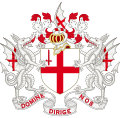History
The Company was originally formed in 1956 when science and manufacturing were key to the UK economy [1] and the memory of war time defence requirements were still fresh and the UK was a large-scale manufacturer of specialist electronic and mechanical scientific instruments. It is one of the Modern Livery Companies formed since 1926 [2] having been granted its livery status by the City in 1963. [3] In 2021, it was granted a Royal Charter.
As with the original Livery Companies it supports the profession and the craft of scientific instrument making, this is achieved through the exchange of ideas and information between members and guests, and also by its charitable donations supporting those in or retired from the profession.
The Company shares Glazier's Hall with two other Companies. The Hall was originally a tea warehouse and is built into the structure of London Bridge. Although the Livery Hall appears to be outside the boundary of the City of London, [4] it is actually in the Ward of Bridge and Bridge Without and so linked to the Bridge Ward Club.
The Livery has a long-standing connection with the Institute of Measurement and Control, the Scientific Instrument Society and a number of other bodies related to measurement such as UKAS, NPL and BSi.
The history of the Company has been documented in two publications created by Past Masters and these can be downloaded here.
Membership and Governance
Members, although from diverse areas such as nanotechnology, mechanical engineering, genetics and astronomy, industry and academia, must be connected to instrumentation or measurement in some way to join.
The Company has four levels of membership. [8] Younger members (from 16 years old) who are still studying or in training can be Apprentices. This enables them to receive financial and/or mentoring support. The next is Freeman, usually someone who is early in their career; then up to Liveryman who are established in their profession and eligible to serve on the Court and progress to Master. Occasionally, Honorary Freemen are admitted as a result of serving the Company or profession in some significant way.
This page is based on this
Wikipedia article Text is available under the
CC BY-SA 4.0 license; additional terms may apply.
Images, videos and audio are available under their respective licenses.

